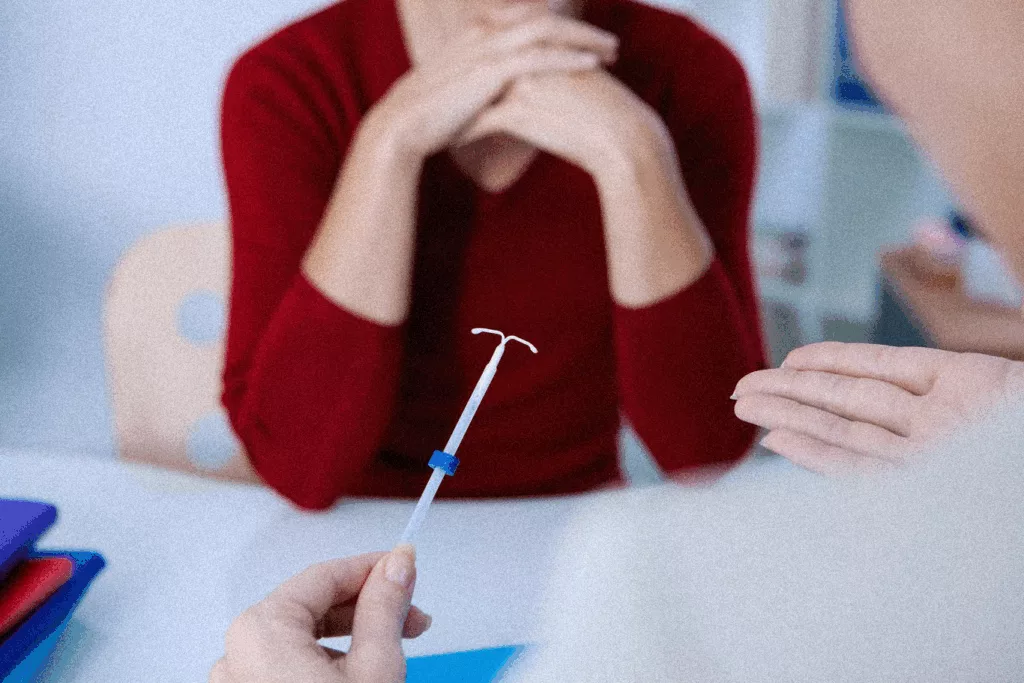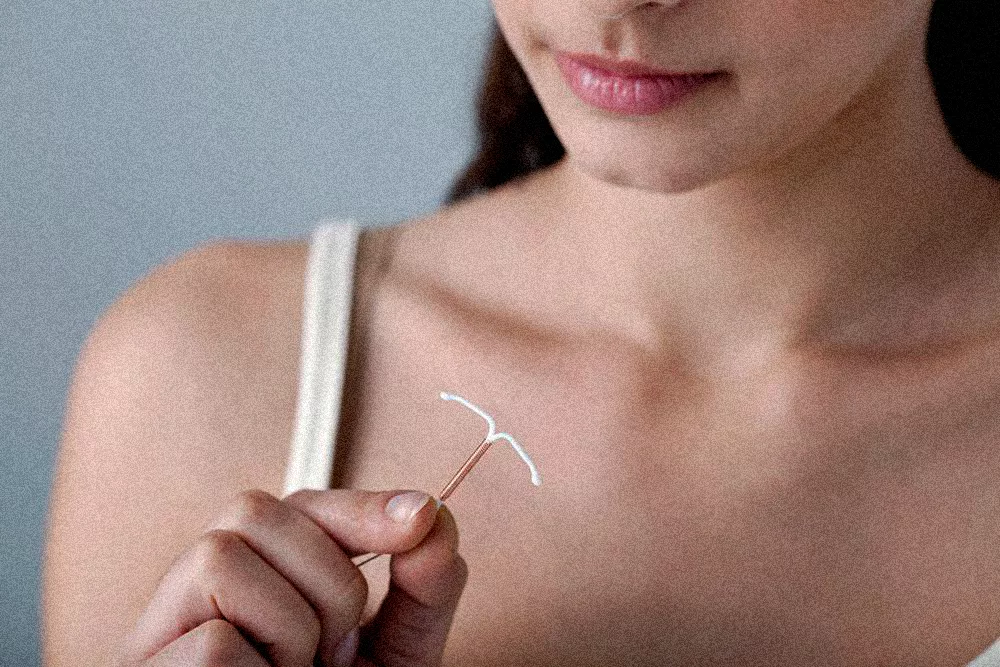Mirena IUD Insertion in Warsaw
INTRAUTERINE DEVICE (IUD):
INSERTION AND REMOVAL
Insertion and removal of an intrauterine device (IUD) at our clinic is performed only after a prior consultation with a gynecologist. During the first visit, the doctor evaluates the indications, discusses all details with the patient, and issues a prescription. The actual procedure of inserting or removing the IUD is carried out during the second visit under the supervision of an experienced specialist, following all safety and comfort standards.
Intrauterine device: types, effects, advantages and disadvantages
Table of Contents
Highlights
- The IUD is an effective and long-term method of contraception, which is divided into hormonal and copper, with different mechanisms of action.
- The advantages of using intrauterine devices are long-term protection against pregnancy and ease of removal, which allows you to quickly restore fertility.
- The disadvantages of intrauterine contraceptives include the possibility of side effects, such as menstrual cramps, and the need for regular follow-up visits to a gynecologist.
What is an intrauterine device?
The intrauterine device is a long-term contraceptive method designed to effectively prevent pregnancy. It is a small, flexible T-shaped object that is inserted into the uterine cavity. One of the key advantages of intrauterine contraception is its reversibility – after its removal, a woman’s fertility returns to normal, and the IUD can be easily reused.

The IUD is made of flexible plastic, which makes it comfortable to wear. Despite its small size, only 3-4 cm long, the IUD can effectively protect against pregnancy for several years. Due to its shape and material, the IUD is almost invisible to the user.
There are two main types of IUDs on the market: hormonal and copper. Each type has its own characteristics and mechanisms of action, which we will describe in the following sections of this guide.
Types of intrauterine devices
Intrauterine devices are divided into two main types: hormonal and copper. Both types have different mechanisms of action and duration of effectiveness, making them suitable for different needs and preferences. Choosing the right IUD often depends on a woman’s individual expectations and health status.
Hormonal IUDs release active substances into the body, while copper IUDs work by releasing copper ions. Each type has its own advantages and potential side effects that should be considered before making a decision.

Hormonal inserts
Hormonal intrauterine contraceptives work by releasing levonorgestrel, which leads to atrophy of the glandular epithelium in the uterus. Levonorgestrel is a synthetic hormone that effectively prevents ovulation, thickens cervical mucus, and inhibits endometrial growth. These mechanisms make the hormonal intrauterine device one of the most effective contraceptive methods.
The effectiveness of IUDs is about 99.8%, making them virtually foolproof. They can last from three to five years, which means that users can enjoy long-term protection without having to remember to use contraceptives every day.
Copper inserts
Copper intrauterine devices release copper ions, which cause inflammation in the uterus and make it difficult for a fertilized egg to implant. Copper ions also have a spermicidal effect, which further increases the effectiveness of this method.
Copper IUDs are more than 99% effective and can be used for 5-10 years. However, they can cause more severe menstrual pain and heavy bleeding, which can be a significant limitation for some women.
How does the intrauterine device work?

The action of the intrauterine device is based on local inflammatory reactions and thickening of cervical mucus, which impedes the movement of sperm. This significantly impedes sperm access to the egg, effectively preventing fertilization.
The hormonal intrauterine device releases levonorgestrel, which inhibits endometrial development and increases the density of cervical mucus. In addition, hormonal intrauterine devices can reduce the frequency of menstrual bleeding by blocking the growth of the endometrium.
Copper intrauterine devices cause inflammation in the uterine cavity, which reduces sperm motility and prevents fertilization. The copper ions released by the IUD have a spermicidal effect, which further increases the effectiveness of pregnancy prevention, and can also affect the cervix.
The process of inserting an intrauterine device
The intrauterine device is inserted in the gynecologist’s office using an applicator that inserts the IUD through the cervix into the uterus. Before inserting the intrauterine device, the doctor performs tests to rule out pregnancy and sexually transmitted infections. The process may be accompanied by some discomfort, but is usually quick and safe.
After insertion of the IUD, it is recommended to visit a doctor in 4-12 weeks to check the correct positioning. If you experience any alarming symptoms, such as severe pain or bleeding, contact your doctor immediately.
Advantages and disadvantages of using an intrauterine device


The IUD is a long-term method, meaning it can work for several years without the need for regular replacement. It is highly effective at preventing pregnancy, making it an attractive option for many women. In addition, it eliminates the need to remember to use contraceptives on a daily basis, which is very convenient.
However, you should not lose sight of the potential disadvantages of this method. After insertion of the intrauterine device, you may experience unpleasant sensations such as cramps, abdominal pain, and mild discomfort. There is also a risk of health complications that some women may experience.
Advantages of the intrauterine device
The IUD provides long-term protection against pregnancy, which can last from three to five years. Women who use an intrauterine device do not need to remember to take contraceptives on a daily basis, which is very convenient in everyday life.
Moreover, the removal of the IUD leads to a rapid restoration of fertility, often as early as the next menstrual cycle. Thus, women can plan their pregnancy according to their needs and decisions without worrying about the long-term consequences of contraception.
Disadvantages of the intrauterine device
IUDs carry a risk of side effects, such as pelvic infections. Side effects of intrauterine devices include menstrual cramps and discharge in the first few days after insertion.
There is also the possibility of painful, heavy and prolonged menstruation, which can be a serious obstacle for some women. There is also a real risk of IUD dislodgement, which may require medical intervention.
Contraindications to the use of an intrauterine device
Contraindications to the use of intrauterine devices include several serious medical conditions that can increase the risk of complications. These include suspected pregnancy, unexplained bleeding from the reproductive tract, and cancer. Before having an IUD inserted, you should undergo a thorough examination to rule out the presence of these health problems.
People with hormone-dependent cancer should not use intrauterine devices. In addition, other health conditions, such as anemia, endometriosis, or anatomical defects in the uterus, may also prevent the use of an IUD for hormonal contraception. In such cases, your doctor may recommend alternative methods of contraception.
The effectiveness of the intrauterine device
Intrauterine devices are one of the most effective methods of contraception, with a Perel index of over 99%. Copper IUDs are about 99.4% effective, making them a reliable option for many women. Hormonal intrauterine devices are even more effective – their efficiency reaches 99.8%. IUDs are a popular choice among women who want long-term protection.
Factors that affect the effectiveness of the intrauterine device include improper insertion and unnoticed fallout. Regular visits to the gynecologist will help to control the correct placement of the intrauterine device and ensure its effectiveness.
Safety of hormonal contraception
IUDs are considered a safe method of preventing pregnancy with minimal risk of serious complications. Potential side effects of hormonal IUDs include headaches, nausea, and mood changes. These symptoms are usually mild and go away on their own.
If you experience serious side effects, such as infections, you should see your doctor quickly. Regular check-ups will help detect possible problems at an early stage and prevent more serious complications.
Intrauterine device and fertility
The intrauterine device does not have a long-term effect on a woman’s fertility. It is a contraceptive that can be removed at any time. After the IUD is removed, fertility returns to normal. This means that the possibility of pregnancy is restored. The IUD also does not have a teratogenic effect on fetal development, i.e. it does not cause birth defects.
If the intrauterine device is removed, women can expect to restore fertility in the next menstrual cycle. Similarly, fertility is restored immediately after the IUD is removed. Removal of the intrauterine device does not negatively affect the ability to become pregnant.
The cost of an intrauterine device
Prices for intrauterine devices vary from 40 to 900 PLN, depending on the type. The cost of the IUD insertion procedure in public institutions is compensated by the National Health Fund. In private clinics, the total cost of IUD insertion is 1000-1500 PLN.
IUD insertion in public institutions should be free of charge, except for the cost of the IUD itself. IUDs can be expensive, which is often cited as a negative aspect of their use.
Conclusion
In conclusion, the intrauterine device is an effective and long-term method of contraception that has many advantages, such as high efficiency, convenience, and reversibility. The choice between a hormonal or copper IUD depends on individual preferences and health needs. It is important to consult your doctor and carefully discuss the pros and cons before making a decision.
We hope this guide has helped you better understand intrauterine contraceptives and make an informed decision. Remember that choosing the right contraceptive method is crucial for your health and comfort. Take care of yourself and make informed decisions.
Frequently asked questions
The IUD works by causing local inflammatory reactions and thickening of cervical mucus, which impedes sperm movement and prevents fertilization. It is an effective method of contraception.
The insertion of an intrauterine device may cause some discomfort, but usually this process is quick and safe. After the IUD is inserted, it is important to make a follow-up appointment.
The main advantages of the IUD are long-term protection against pregnancy and high efficiency, which eliminates the need to remember to take contraceptives daily. This solution provides convenience and safety in family planning.
Potential side effects of using an IUD include menstrual cramps, spotting, heavy bleeding, and the risk of pelvic infection. It is important to be aware of these possibilities before deciding to use it.
The cost of IUD placement in public institutions is compensated by the National Health Service, while in private clinics it can range from 1000 to 1500 pounds.